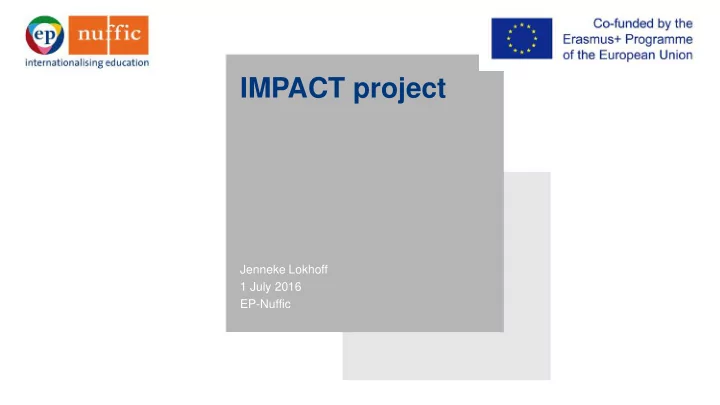

IMPACT project Jenneke Lokhoff 1 July 2016 EP-Nuffic
Goals Extend the quality assurance and peer review system of recognition offices, including facilitating a new round of peer reviews; Explore how to connect admissions officers to the ENIC-NARIC networks and launch a first version of a European Admissions Officers platform; Assess the impact of the ENIC-NARIC networks on recognition in the EHEA (making use of EUA’s evaluation expertise).
Project team Core team: Denmark, France, Italy, Lithuania, The Netherlands (coordinator), United Kingdom + EUA Sub team: Ireland, Latvia; Steering Group: President ENIC Bureau, Vice-president LRC Committee, BFUG Representative, ECA, EUA and HRK -> Plus observer Duration: 1 March 2016 – 28 February 2018
QA System System of Quality Assurance for the Recognition Networks Developed in EARN (2012 – 2014) and SQUARE (2014 - 2016) projects Voluntary exercise Tailor made for different types of centers: Typology Self – Evaluation & Peer review based on Standards & Guidelines Based on Lisbon Recognition Convention, previous projects (European Area of Recognition, EAR manual), ENIC-NARIC Charter, Pan-Canadian QA Framework, ESG for accreditation
Typology of ENIC-NARIC centres Survey within the networks: >50 respondents Interpretation of the status, setting and tasks of the centre into a few main categories
Standard 1 – Procedures, criteria and quality assurance The ENIC/NARIC office aligns its recognition criteria and procedures with established good practice, reviews its procedures on a regular basis, and ensures that the criteria are consistently applied.
6 Standards Standard 1 – Procedures, criteria and quality assurance Standard 2 – Applicant-centred recognition Standard 3 – Quality, legitimacy and authenticity Standard 4 – Evaluation tools and resources Standard 5 – Transparency and information provision Standard 6 – (Inter)national cooperation and presentation
Satisfied centre 1 “Preparation for the self-evaluation was a very good experience for us and very useful, since we did it for the first time and it helped us to see where we needed to grow and improve”
Satisfied centre 2 “The protocol seemed at first very formal and detailed, however when both working on our self-evaluation and planning the site visit we found it very useful and practical to use. The standards are relevant both with regards to the LRC and to our own further development according to our centre’s strategy”.
Peer reviewed centres 2012 – 2014 (EARN) 2014 – 2016 (SQUARE) 1. France 1. Ireland 2. UK 2. Slovenia 3. Poland 3. Czech Republic 4. The Netherlands 4. Norway 5. Bosnia Herzegovina 6. Ukraine 7. Italy 8. Lithuania 9. Canada 10. Spain
FAIR & the inclusion of recognition in accreditation procedures Jenneke Lokhoff 1 July 2016 EP-Nuffic
FAIR Aim: Improve recognition practices HEIs by implementing elements of automatic recognition. Objectives Identify essentials in recognition procedures of HEIs, develop practical guidelines and provide consultancy in streamlining these procedures; Gain commitment at policy level to effectuate the implementation of forms of automatic recognition in each participating country.
Experimentation & Pioneering
FAIR (2) KA3 Erasmus+ Policy Experimentation. Scientific: - 2 Trials - Evaluation Body (EUA) - Peer Review (Danish NARIC) Representation high level bodies from 6 countries: - Ministry of Education; - ENIC-NARIC centre (or representative; - Group of 22 institutions (4x4 + 2x3). + ECA Croatia, Belgium (Flanders), Italy, Spain, Germany and The Netherlands
FAIR (3) I - Planning 1 - Experimentation Protocol 1/1/’15 – 2 - Legal arrangements 1/3/’15 3 - Kick-off meeting II – Field Trials 4 - Field trial 1: Baseline assessment recognition procedures 1/3/’15 – 5 - Analysis Baseline assessment 1/10/’16 6 - Project team meeting 7 - Implementation improved recognition procedures 8 - Field trial 2: Impact analysis III – Evaluation 9 - Analysis of field trials & Recommendations 1/09/’16 – 1/1/’17 IV – Dissemination 10 – Dissemination of project results 1/1/’15 – 30/4/’17
FAIR (4) Jul/Aug 2016: deadline submission evaluation forms; EUA develops progress reports, incl. lessons learnt, good practice and challenges encountered for participating universities (Summer 2016) National/European recommendations (Autumn 2016) National Exploitation meetings (Winter 2016/2017)
Main outcomes Trial 1 (1) General: European Recognition Area is highly diversified; Use of relevant terminolgy is not consistent across institutions and countries; There is no predictable pattern for the role of external bodies in recognition and admission activities; Centralised vs decentralised models; Binarism and regionalism complicate the European landscape; Lack of familiarity with the Lisbon Recognition Convention; No evidence that recognition and admission practices are anywhere subject to systematic quality assurance, either internal or in external accreditation.
Main outcomes Trial 1 (2) Procedure: lack of comprehensive public information; no provision for refugees; inadequacy of internal quality assurance; lack of (integrated) database/archive; Absence of (public information on) the appeals procedure; Absence, or inaccuracy, of public information regarding average processing time; Absence of procedure for RPL.
Questions Is recognition of qualifications part of your accreditation procedure? - If so: what indicators do you use? - Do you feel these indicators are sufficient? If not, what could be changed and what are the challenges for doing so? If recognition is not part of your accreditation system: - Are you considering to include recognition? - Are there any challenges to include recognition in your system? If so which? - What indicators do you think would be appropriate to measure recognition?
For more information about FAIR, contact Jenneke Lokhoff: jlokhoff@epnuffic.nl Katrien Bardoel: kbardoel@epnuffic.nl Bas Wegewijs: wegewijs@epnuffic.nl
Recommend
More recommend